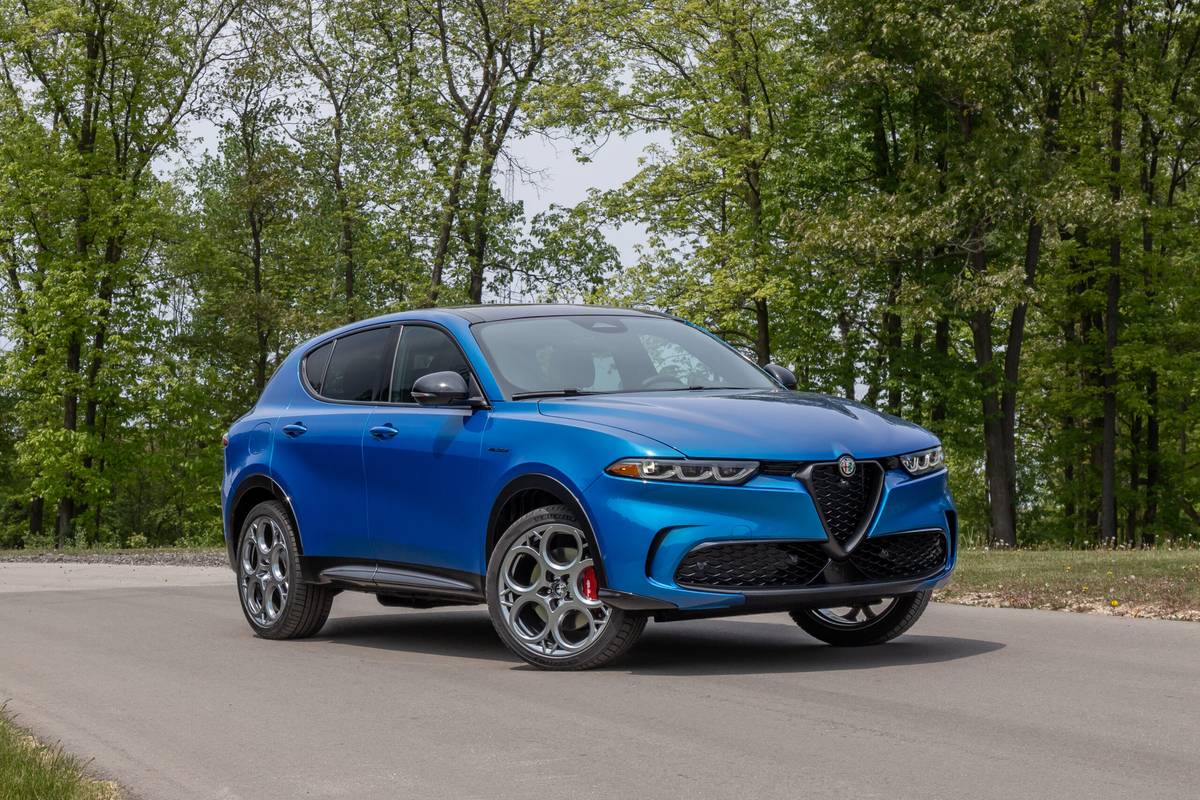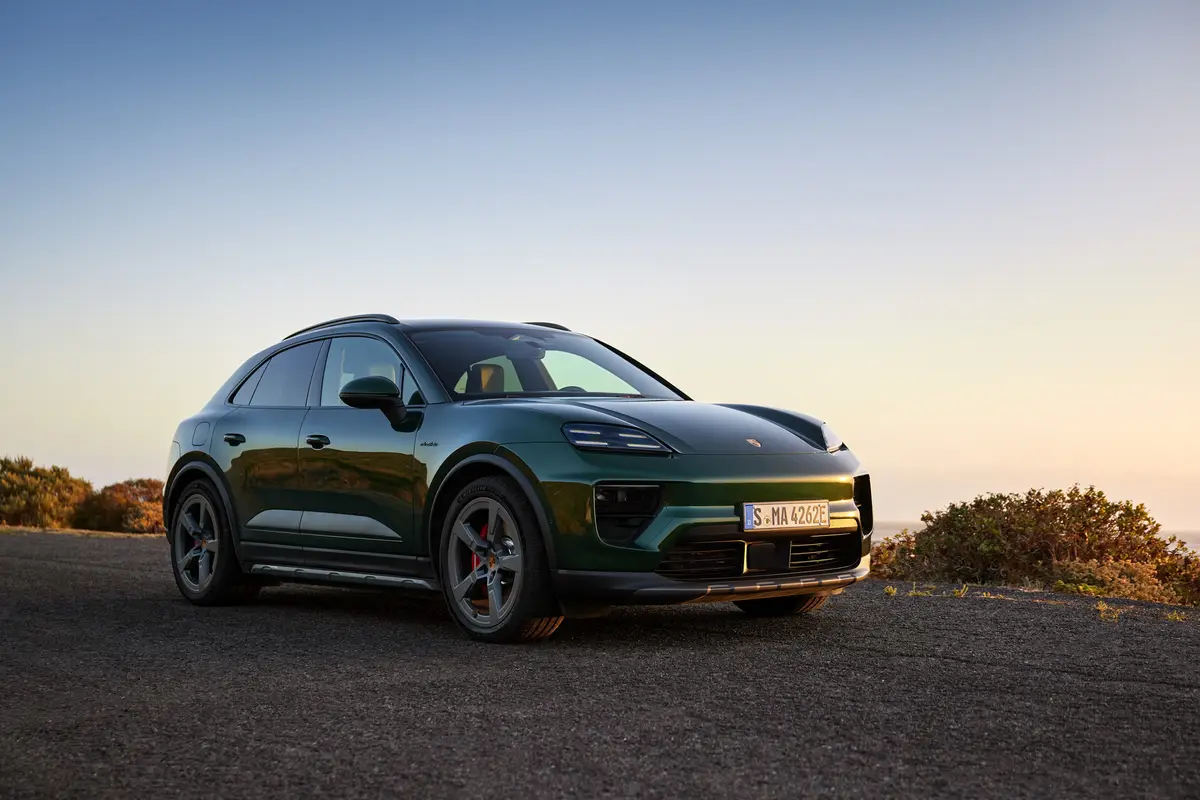Video: 2018 Alfa Romeo Stelvio Review
By Cars.com Editors
June 22, 2017
Share
About the video
On the heels of the engaging Giulia luxury sports sedan, the Italian Alfa Romeo brand is bringing to the U.S. its first SUV, the Stelvio. Two things tend to establish Alfa Romeos: how they look and how they drive. Learn all about both in the video.
Transcript
(engine starts and revs) On the heels of the engaging Giulia luxury sports sedan, the Italian Alfa Romeo brand is bringing to the United States its first sport utility vehicle, the Stelvio.
Now, the Stelvio competes roughly with things like the BMW X3, the Infiniti QX70, particularly the Porsche Macan and the Jaguar F-Pace. Now, two things tend to distinguish Alfa Romeos. One is how they look. And even though this is a design you don't see that much in America, it's been around for decades. This shield grill and overall front-end design, it manages to make the vehicle look really distinctive in the US market, without looking ugly. The other thing that Alfa Romeos are known for is how they drive. So let's take a look for the first time at how the Stelvio takes to the streets. (car whooshes softly) Unfortunately, the full-performance Quadrifoglio version of the Stelvio doesn't come until 2018. They're launching, starting now, essentially, June/July in dealerships near you, with the regular Stelvio and Stelvio Ti. What we have here is the first catch of the day, the Stelvio Ti, equipped with the Sport package. When the Giulia sedan came out, it started out in the Quadrifoglio version, which is the performance version. They flipped it for the Stelvio. And I was a little disappointed at first, until I found out that the regular Stelvio, and Stelvio Ti, which is what we're driving right now, has 0 to 60 times of roughly five and a half seconds, which is pretty darn good. Overall, the powertrain is pretty impressive. It is a two-liter, turbocharged four-cylinder. It has 280 horsepower and 306 pound-feet of torque. Now, the specs say that that torque peak starts at about 2000 RPM. It feels like it's probably a little bit higher than that. When you stand on it from a stop, it does tend to take a little bit of time to get going. Like, it needs to get through first gear. But it definitely delivers after that point. One of the strongest aspects of the Stelvio is its powertrain. Not just strong in terms of horsepower, but the way the transmission behaves. It is super, super responsive. It upshifts quickly, it downshifts quickly. And you feel it when you're in an automatic mode. But you can really see it if you go into manual and use the paddles. And the paddles come in the optional Sport, or performance packages. I'm just, you know, whacking these paddles, and the tachometer needle just jumps immediately. And it's not to say there aren't other vehicles out there that have quick-reacting transmissions, but more often we see this in dual-clutch automated manuals. This is more of a conventional automatic transmission from ZF, the supplier in Germany. And many manufacturers use this transmission, but I gotta tell you, it is not this quick in those vehicles as it is here. And I also like how big these paddles are. They're big, aluminum paddles attached to the columns. So you always know where they are, even if you're in normal driving. You're turning at an intersection or something like that, the steering wheel is turned more than a few degrees, you still know the paddles are there, pretty much start to finish. If you're going to have an automatic transmission and attempt to make the car sporty, the Stelvio does it right. A quick-reacting automatic with really big metal paddles attached to the steering column. That's the way to go. The Stelvio handles really nicely. The specs say that the weight distribution is 50-50, front-rear. Actually feels like there's a fair amount of understeer going into a corner, which is okay, it's safe. Q4 all-wheel drive is standard, but technically the layout of this platform is a rear-wheel drive architecture. So you really have the feel of a rear-wheel drive car, even though it is all-wheel drive all the time. It sends all of the torque to the rear wheels, but can send as much as 60% to the front when it's needed. Overall, the steering is nice and precise, but it also isn't quite as light as it felt in the Giulia. I thought that the steering in the Giulia sedan was over-boosted. In this, it feels a lot better matched. And there is an adjustment when you choose the different modes. Dynamic mode will give you the least power assist and a little bit more feedback than the natural and advanced-efficiency settings. Now, along with all the positive aspects of driving the Stelvio, there's one that I think is a negative, and that is the braking. Now, the actual braking force is good. It'll bring the car to a stop. You get standard Brembo four-piston front and single-piston rear calipers, good hardware. It's the pedal feel that I'm not crazy about. Feels kind of numb to me, and not particularly linear. So now I'm driving what might look the same. It's a different Stelvio. This is a base model. It is not the Ti and it doesn't have the optional Sport package. So what that means is, it has a base suspension, which is not tuned for sport. So between the softer suspension and the taller sidewalls on the tires, this definitely rides softer, and I felt considerably more body roll in the curves in this one. So I would say if you want a sportier vehicle, definitely go for the Sport option package. And you're not really giving much up. The ride quality in the Stelvio Ti with the Sport package was perfectly comfortable. I wouldn't say soft, but comfortable. A sophisticated ride, not at all punishing. Bears noting, even though this doesn't have the paddles, you can still pop the lever into the manual mode and the transmission behaves just as quickly, it responds just as quickly as it did in the version with the Sport package. The interior is pretty nice. Generally speaking, the materials quality is good for this price. One of the best things you get is real genuine leather standard in all Stelvios. And that is not the case in all luxury cars, especially German luxury cars. I also find these seats to be quite comfortable. This is the Sport package-equipped Stelvio Ti, so it has more adjustments and sportier seats, but even though it has these tight side bolsters, they aren't outrageously tight for a guy of my size. And it does come with the little thigh extension as well. One nice plus about these seats is even though their sports seats are sporty seats, they don't give up the adjustable head restraint. Even though the design is sleek overall, visibility is pretty good in the Stelvio. "A" pillars are a little bit thick, but you can work with it. The "D" pillars are also a little bit thick, but a backup camera is standard, as are rear sonar sensors. One small downside we notice is that the image for the standard backup camera is pretty small. You've got an 8.8-inch display here. This is the upgrade display, and it runs from here to here. Somehow they use only this much of it for the backup camera. They use a little bit more space than is necessary for the graphic representation of the car that shows you what the sonar sensors in the back are seeing when you're backing up. Now, as an option, you can also get front sonar sensors. Point being, this graphic aspect doesn't have to be so big. I'd rather have a nice big backup image. Having been in the Giulia sedan recently, I was really pleased in the Stelvio to find that the controls, the multi-function controller here, has a better feel and sound. In the Giulia, it was more of a rickety feel and sound. In this case, it's much better. Though I have to say the DNA control for the driving modes, probably a little better than the Giulia, but not quite as solid as I'd like. One thing that does carry over from the Giulia, unfortunately, is the spring-back turn-signal lever. Automakers are getting away from this. Even BMW, which started it, has gotten back to the kind where you move it down and it stays there until you make your turn, and then it pops back up. Complicating things further, this one, if you hold it, after a few clicks, it stops clicking even though you're holding it down. It's just a weird thing. Probably wouldn't bother you right now, but once you buy the car and own it, it might bother you. Overall, the Stelvio delivers on Alfa Romeo's promise of style and drivability. And Alfa is being quite aggressive with the pricing, with a starting price of just under $43,000 with the destination charge for the base Stelvio. You get a lot, you get the all-wheel drive, you get the backup camera, the rear sonar, you get Apple CarPlay, Android Auto, bi-xenon headlights, power lift gate, four USB ports, lots of stuff that people want these days. And if you compare that with competitors, the Jaguar F-Pace starts at essentially the same price, but that is with the diesel engine. Nice and efficient, but if you want a sporty SUV, you're going to have to go with the gas engine and that's gonna cost you more. And as for the Porsche Macan, for that you pay $5,000 more, and you get less. Sporty SUVs are definitely not a new idea, but somehow the Stelvio makes it feel that way. (car whooshes softly)
Featured stories

By Patrick Masterson
June 17, 2025

By Corinne Vercoe
April 21, 2025

By Jared Gall
March 14, 2025
